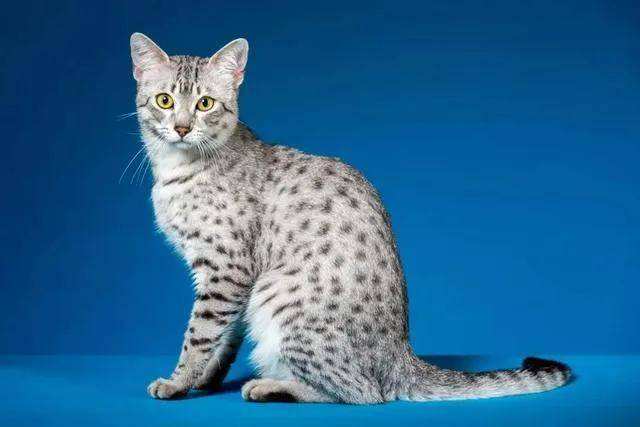Egyptian Mau
IUCN
LCBasic Information
Scientific classification
- name:Egyptian Mau
- Scientific Name:Pharaoh cat, Egyptian god cat
- Outline:Carnivora
- Family:Felidae
Vital signs
- length:35-50cm
- Weight:2.5-7kg
- lifetime:15 year
Feature
Believed to be a cat kept in ancient Egypt
Distribution and Habitat
Native to Egypt
Appearance
The head is slightly rounded wedge-shaped with a slightly raised nose. The face is full; the typical Egyptian cat has an "M"-shaped pattern on the forehead and patterns on the cheeks. The ears are slightly pointed and slightly larger, with frills on the inside of the ears. The eyes are large, almond-shaped, and light green or glassy green. The body is medium-sized, graceful, and belongs to the slender Oriental type. The tail is thick at the base and slightly thin at the tip. The limbs are long.
The fur is soft, smooth and shiny. There are five colors, from the most precious to the most common: silver, bronze, smoke gray, black, blue/white ash. Egyptian cats with black to white ash colors will not be exhibited, but will be used for breeding. All Egyptian cats participating in the exhibition must have green eyes. However, amber eyes are also acceptable for kittens to 18 months old.
Details
The Egyptian cat is an ancient breed, and there are graphic and text records of it on tombstones and scrolls in ancient Egypt thousands of years ago.

As the name suggests, the Egyptian cat originated in Egypt. In the history of domestic cats, the Egyptian cat may be the earliest. 1400 years ago, images of spotted cats were painted on the walls of ancient Egyptian temples on the banks of the Nile. Murals and papyri from the ancient Egyptian era all depict cats that look like today's Egyptian cats. Egyptian cats were considered ordinary creatures during the reign of Constantine, in the 4th century AD, when they began to exist as ordinary small creatures. The Egyptian cat has spots on its body, and the formation of a fixed breed originated from a princess in the Mediterranean region in the 19th century. She liked a cat imported from Cairo very much, and mated it with an Italian cat to give birth to offspring. Later, the offspring of the cat were brought to the United States for reproduction, and were registered and exhibited in the United States for the first time the following year, and were generally welcomed by American families. Egyptian cats and Abyssinian cats are believed to be cat breeds raised by ancient Egyptians.
Egyptian cats are one of the original breeds of modern domestic cats. Because they are very different from other modern domestic cats in terms of body structure, growth and behavior, it can be seen that it is very old, or at least the habits of this breed are very special. Egyptian cats are very sensitive to temperature and like warm places very much. They are very sensitive to drugs and anesthetics.
Another very special thing about Egyptian cats is their eyes. Their eyes are usually light green, glass green or millet green. The color of the kitten's eyes will change with the change of mood. When it is happy, its eyes will become more and more green, and when it is angry, its eyes will turn amber. Therefore, the owner can judge its mood according to the change of its eye color.
Egyptian cats are smart and gentle, timid and fragile, have good memory, are very patient with children, and have a soft and beautiful voice. They are afraid of strangers and are suitable for family breeding. Egyptian cats are very smart and like to be close to responsible and caring owners. Many of these cat owners said that when they came home after a day's work, they would find their cats sitting in front of the door waiting for them eagerly.
Protect wild animals and eliminate game.
Maintaining ecological balance is everyone's responsibility!








